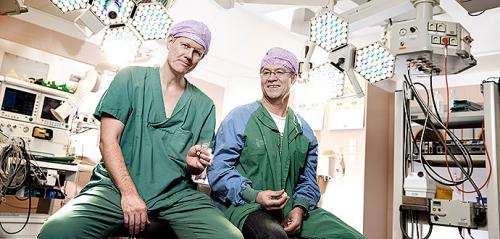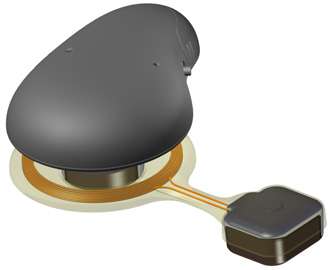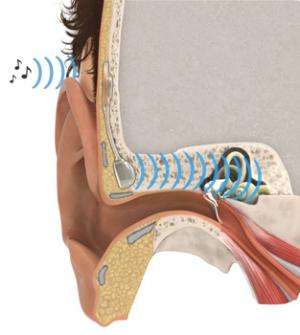New implant replaces impaired middle ear

(Medical Xpress)—Functionally deaf patients can gain normal hearing with a new implant that replaces the middle ear. The unique invention from the Chalmers University of Technology has been approved for a clinical study. The first operation was performed on a patient in December 2012.
With the new hearing implant, developed at Chalmers in collaboration with Sahlgrenska University Hospital in Gothenburg, the patient has an operation to insert an implant slightly less than six centimetres long just behind the ear, under the skin and attached to the skull bone itself. The new technique uses the skull bone to transmit sound vibrations to the inner ear, so-called bone conduction.
"You hear 50 percent of your own voice through bone conduction, so you perceive this sound as quite natural", says Professor Bo Håkansson, of the Department of Signals and Systems, Chalmers.
The new implant, BCI (Bone Conduction Implant), was developed by Bo Håkansson and his team of researchers. Unlike the type of bone-conduction device used today, the new hearing implant does not need to be anchored in the skull bone using a titanium screw through the skin. The patient has no need to fear losing the screw and there is no risk of skin infections arising around the fixing.
The first operation was performed on 5 December 2012 by Måns Eeg-Olofsson, Senior Physician at Sahlgrenska University Hospital, Gothenburg, and went entirely according to plan.
"Once the implant was in place, we tested its function and everything seems to be working as intended so far. Now, the wound needs to heal for six weeks before we can turn the hearing sound processor on", says Måns Eeg-Olofsson, who has been in charge of the medical aspects of the project for the past two years.
The technique has been designed to treat mechanical hearing loss in individuals who have been affected by chronic inflammation of the outer or middle ear, or bone disease, or who have congenital malformations of the outer ear, auditory canal or middle ear. Such people often have major problems with their hearing. Normal hearing aids, which compensate for neurological problems in the inner ear, rarely work for them. On the other hand, bone-anchored devices often provide a dramatic improvement.
In addition, the new device may also help people with impaired inner ear.
"Patients can probably have a neural impairment of down to 30-40 dB even in the cochlea. We are going to try to establish how much of an impairment can be tolerated through this clinical study", says Bo Håkansson.

If the technique works, patients have even more to gain. Earlier tests indicate that the volume may be around 5 decibels higher and the quality of sound at high frequencies will be better with BCI than with previous bone-anchored techniques.
Now it's soon time to activate the first patient's implant, and adapt it to the patient's hearing and wishes. Then hearing tests and checks will be performed roughly every three months until a year after the operation.

"At that point, we will end the process with a final X-ray examination and final hearing tests. If we get good early indications we will continue operating other patients during this spring already", says Måns Eeg-Olofsson.
The researchers anticipate being able to present the first clinical results in early 2013. But when will the bone-conduction implant be ready for regular patients?
"According to our plans, it could happen within a year or two. For the new technique to quickly achieve widespread use, major investments are needed right now, at the development stage", says Bo Håkansson.
Two parts – one exterior processor and one implant
The implant is slightly less than six centimetres long. By a surgical procedure, it is inserted just behind the ear, under the skin, into the bone itself. The coil at the upper end operates using magnetic induction with the outer, visible component, a sound processor that the patient easily can attach to or remove from the head.

The external sound processor is held in place using two magnets. The titanium screw through the skin, used in other techniques, is replaced by an inductive link that transmits sound from the patient's surroundings through the intact skin to an internal receiver. The audio signal is transmitted to a tiny quadratic loudspeaker anchored to the bone near the auditory canal. The speaker generates sound vibrations which reach the sensory organs of the cochlea.
Deaf people will gain normal hearing and function
Hearing impairments are the most common physical disability in the industrialized world. If the problem originates in the mechanism required to conduct the sound to the inner ear – for example, in the ear canal or the small bones in the middle ear – the skull bone can be used instead. Soon, functionally deaf people will gain normal hearing with the implant pictured, known as the Bone Conduction Implant (BCI).
"The implant will be very comfortable and aesthetically attractive. Because the implant is securely fixed under the skin, the patient won't need to be more careful than other people during, for example, outdoor activities and water sports", says Professor Bo Håkansson.
Chalmers and Sahlgrenska working closely together since the 1970s
In 1977, three adult patients had titanium screws inserted into the bone behind the ear at the Ear Clinic of Sahlgrenska University Hospital. This was the starting point for close, long-lasting cooperation between Professor Bo Håkansson, Associate Professor and Ear Specialist Anders Tjellström and Professor P-I Brånemark, renowned for his concept of permanently anchoring implants in the bone, known as osseointegrated implants.
The BAHA (Bone Anchored Hearing Aid) technique has undergone gradual refinement since then and is today helping more than 100,000 patients worldwide to better hearing – and the number is rising. The BAHA technique has never gained so much international recognition as it has today, one success factor being the cross-discipline teamwork that has been ongoing in Gothenburg without interruption for more than 35 years.
















